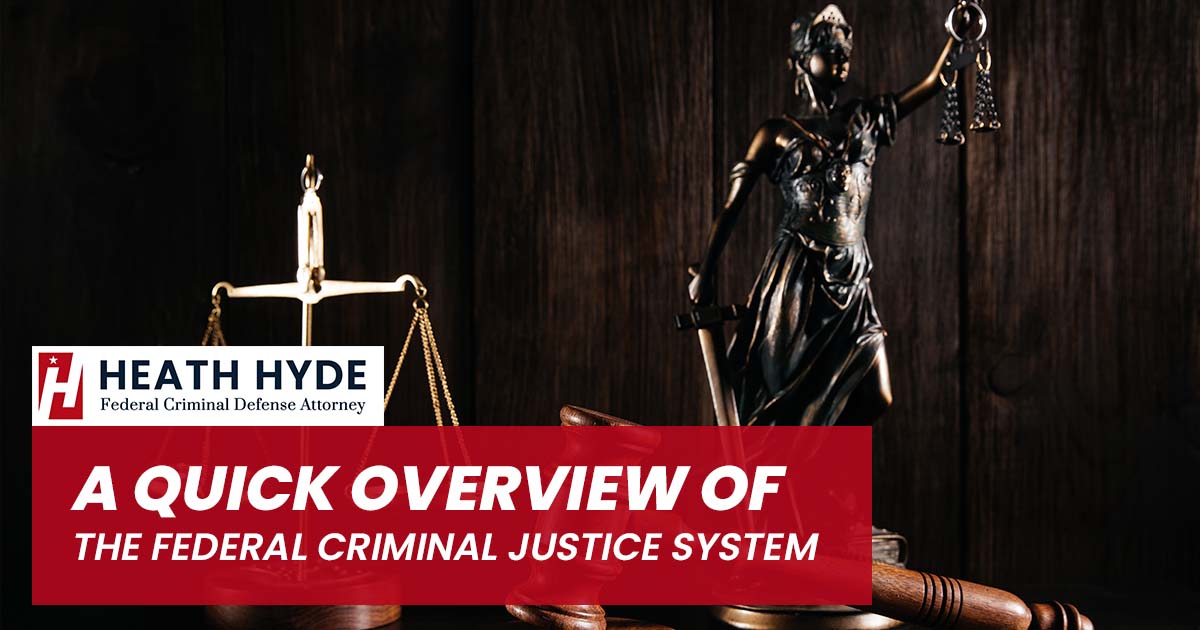Some victims are unaware of how the federal criminal justice system works. Others’ understanding is restricted to what they’ve seen on TV or in movies, which is frequently incorrect. This article briefly summarizes common stages performed in the investigation and prosecution of a federal crime to help victims better understand how the federal criminal justice system works.
Not every step outlined below will take place in every situation. Additional events or proceedings may be included in the investigation or trial in some situations, all of which can take a long time to complete. The process in a specific case might be explained by an FBI victim expert or the victim-witness coordinator at the US Attorney’s Office.
Federal Criminal Justice Process
I. The Pretrial Stage
Investigations, Grand Juries, and Arrests
If a federal crime is reported to federal authorities (for example, a bank robbery), a federal law enforcement agency will investigate to see if a federal offense was committed and, if so, who committed it. It’s important to remember two things:
First and foremost, not all crimes are federal offenses. Murder, for example, is a state-level offense in all 50 states, but it is not a federal violation unless a federal official is killed while executing official duties. Every state prohibits robbery, but it is not a federal crime unless there is a link to the federal government, such as a robbery of a federally insured bank. Only if there is grounds to think that a crime has broken federal law would federal law enforcement agencies examine it.
Second: The nature of the federal offense may determine which agency undertakes the investigation. Not every federal law enforcement agency has the responsibility to investigate every crime. For example, the Secret Service is responsible for investigating counterfeiting of currency, and the FBI is the lead federal agency for terrorism cases. This assignment of functions helps different agencies develop expertise, but it also means that federal law enforcement agencies are not like local police forces—they do not each handle whatever federal crime comes their way.
If the agency concludes that a crime was committed and identifies a suspect, federal law enforcement officers (known as special agents) may make an arrest without obtaining an arrest warrant; may obtain an arrest warrant for a named person; or, in some circumstances, may delay making an arrest in order to obtain additional evidence proving the suspect’s guilt.
In the case of federal offenses that are colloquially known as white-collar crimes (e.g., violations of the federal securities laws), agents often will need to obtain documents from suspects and innocent parties as part of the investigation. To do so, the agents can apply for a search warrant from a magistrate (or judge) to search a particular site for relevant evidence. Alternatively, the agents can request a subpoena from a grand jury.
A grand jury is an impartial body of citizens drawn from the community that has the responsibility to investigate whether a crime has been committed and by whom. In order to make that determination, a grand jury may issue subpoenas to whoever may have evidence relevant to the grand jury’s investigation. As part of its investigation, the grand jury also has power to compel testimony, including the testimony of a crime victim. If the grand jury concludes that there is probable cause to believe that a particular individual committed a crime, the grand jury will issue a charging document known as an indictment. Whenever a grand jury is involved in an investigation, the agents will work closely with an attorney from the U.S. government, either from the local U.S. Attorney’s Office or the U.S. Department of Justice, before making an arrest in order to determine whether a crime was committed and, if so, who is responsible.
Initial Appearance
If a magistrate has issued a search warrant for a suspect or if a grand jury has returned an indictment against a suspect, federal agents will arrest the suspect and place him or her in custody pending court proceedings. If there has been no arrest warrant or indictment, the arresting agents must bring the suspect before a magistrate (or judge), who then will determine whether there is probable cause to believe that the arrestee committed a crime. This initial appearance generally will occur as soon as practicable following arrest and must occur before 72 hours have passed. At the initial appearance, the court will inform the arrestee of the charges and advise him or her of the rights to counsel and to remain silent. In some cases, the defendant may be released at the initial appearance. But in other cases, the prosecutor may seek to have the accused held in custody until the trial has concluded because the accused is seen as a danger to the community.
Crime; Enter into System; Prosecution and Pretrial Services; Adjudication; Sentencing and Sanctions; Corrections
Arraignment
Arraignment is the stage at which the defendant formally is told what the charges are and is given a copy of them. The defendant then enters a plea responding to those charges, which generally is not guilty or guilty. If the defendant and his attorney already have negotiated with the prosecutor and have agreed upon a plea bargain, the defendant may enter a guilty plea at the arraignment as part of the plea bargain. Plea bargaining is discussed below.
Discovery and Motion Practice
After arraignment and before trial, the defendant and the government engage in the discovery and motions process. Discovery is the pretrial process by which the defendant and—to a more limited extent—the prosecutor can demand information and material about the case from the other party. In addition, the defense and prosecution usually engage in considerable pretrial motion practice. A motion is the name given to papers filed with the district court asking it to do something in the case. For example, motions filed by the defense may seek to dismiss the charges, to suppress evidence, or to introduce specific evidence at trial. Motions by the prosecutor may include a request for reciprocal disclosure or a request for defendant to disclose alibi or psychiatric evidence.
A crime victim’s attorney may also file motions asserting the victim’s rights. For example, a victim’s attorney may seek to quash a subpoena issued to a victim to prevent the victim’s personally identifying information (PII) from being made public, or allow the victim to remain in the courtroom during the trial.
Plea Bargaining
The government and the defendant may agree to forego a trial and have the defendant enter a plea of guilty as part of a plea bargain. A plea bargain is an agreement that the defendant will plead guilty to the original or another charge in return for some concession from the prosecutor. Typical concessions include dismissal of other charges or a recommendation to the judge for a particular sentence (or an agreement not to oppose the defendant’s request for a particular sentence). If charges have been filed, a victim will have a reasonable opportunity to confer with the prosecutor before the plea bargain results in a formal guilty plea. Nonetheless, a victim does not have a right to veto the prosecutor’s decision to engage in plea negotiations or to accept a guilty plea from a defendant as part of a plea bargain.
If a plea agreement has been reached, the government and defense counsel present that agreement to the court. A victim may appear in court and make a statement regarding the plea agreement. If the court accepts the agreement, the court will set a date for sentencing and decide whether the defendant should be held in custody until then. The law does not require a federal court to accept a plea agreement. Rather, the court may accept the agreement, reject it, or discuss with the parties alternatives that are acceptable to the court. If the court rejects the plea agreement, the defendant may withdraw the guilty plea, and the case will proceed to trial.
II. The Trial
A trial is the proceeding during which the government and the defense present evidence to prove or disprove the charges. Ordinarily, a trial is held before a jury, but there are circumstances in which the case will be tried to the judge alone, which is known as a bench trial. The purpose of the trial is to decide whether the government can prove beyond a reasonable doubt the truth of the charges against the accused, but a victim is not a bystander in that process. For example, a victim may be called to testify as a witness to the crime or to explain how the victim was harmed by the crime. Moreover, except in extraordinary circumstances, a victim cannot be excluded from the trial, even if the victim later will testify, which enables a victim to observe the in-court proceedings.
Generally, a trial proceeds as follows:
Voir Dire
Voir dire is the process by which members of the community selected to become potential jurors in a specific case are questioned and selected for a particular case. In a capital case, voir dire is split into two phases: the general voir dire phase and the death qualification phase. The reason for the separate death qualification phase is that the government is entitled to excuse from the jury anyone who will not consider imposing the death penalty when it is a potential punishment in a specific case.
The Guilt Stage: Opening Argument, Presentation of Evidence, Closing Arguments, Jury Instructions, and Deliberations
The guilt phase generally begins with the prosecutor’s opening statement. The defense has the option of making its own opening statement immediately afterwards or reserving its opening statement for the beginning of its case-in-chief. The prosecutor then presents the government’s proof through physical evidence and witnesses. The defense is entitled to cross-examine any witnesses questioned by the government.
Once the government has completed its case, the defense may move the court to acquit the defendant, on the ground that there is legally insufficient evidence to convict. If the court denies the defense motion, the defense may present its own case, and the prosecutor may cross-examine any witnesses presented by the defense. Following the defense case, the prosecutor may present evidence to rebut the defendant’s case.
Once the prosecutor concludes its rebuttal case, the defense again can move for an acquittal. If the court denies that motion, the parties present their closing arguments: first the prosecutor, then the defense, and finally the prosecutor again (the government goes first and last because it has the burden of proof). Following closing arguments, the judge will instruct the jury on the relevant law for it to apply. Afterwards, the jury will retire to decide the case.
When the jury has reached its decision, the jury will return to the courtroom and announce its verdict. If there is no jury, the judge will deliberate and return a verdict.
The Sentencing Stage: The Pre-Sentence Investigation, the Defendant’s Right of Allocution, the Victim Impact Statement, the Parties’ Arguments, and the Imposition of Sentence
If the jury or judge finds the defendant guilty of at least one count charged in the indictment, the court will impose some sentence on the offender. But before the court does so, a probation officer will conduct a background investigation. The probation officer will investigate any aggravating and mitigating factors present in the case and will prepare a pre-sentence report summarizing those factors for the judge.
Most reports contain a variety of information that may be helpful to the court: e.g., information about the offender’s prior criminal record, personal characteristics, financial condition, social history, and circumstances affecting his or her behavior, as well as information regarding the effect of the crime on the victim.
Regarding that last subject: During the background investigation, a probation officer will speak with the victim. The officer also will ask the victim to complete a form and to provide whatever documents the victim may have showing losses or expenses caused by the crime (e.g., medical bills, lost income, etc.)
The victim also will have an opportunity to prepare what is called a victim impact statement—a statement describing, in the victim’s own words, the effect of the crime on the victim. That statement will be presented to the judge and made a part of the record at sentencing.
The offender has the right to be present for sentencing, as does a victim. Both persons may make a statement before the court imposes sentence. The lawyer for the government and the offender also will address the court regarding the sentence. If a victim is represented by an attorney, the victim’s counsel also can address the court at sentencing.
After hearing from those parties and the government, the court may sentence the offender to imprisonment, probation, community service, or another such program. If an offender is imprisoned, the offender will be placed on a period of post-release supervision.
The court also can fine the offender or order the offender to pay restitution to the victim. Restitution is a monetary payment made by an offender to the victim to compensate the victim for the financial harm caused by the crime. In some cases, restitution is a mandatory component of the sentence, and the judge must order to offender to pay it. A victim can urge the court at sentencing to enter an order requiring the offender to make restitution to the victim.
III. Post-Trial Proceedings
After sentencing, the offender may appeal his conviction or sentence in the hope of having either one set aside. An offender has the right to appeal to a circuit court of appeals. If that court does not grant the offender the relief he seeks, he or she can ask the U.S. Supreme Court to review the case, but the Supreme Court has discretion whether to review an offender’s case, and it reviews very few federal criminal cases each year.
If the Supreme Court decides not to review the offender’s case (or, if it does, but upholds his conviction and sentence), the judgment against the offender now is final. At that point, the offender has few opportunities to obtain relief.
The offender can challenge his conviction or sentence in a habeas corpus proceeding, but there are only limited opportunities for the offender to obtain that relief. A victim can attend in-court proceedings involving the offender’s habeas corpus challenge to his conviction or sentence.
Another avenue of relief is to ask the president for clemency—that is, to pardon his crime or reduce his sentence—but the president exercises his clemency power rarely. A victim does not have a right to attend Justice Department meetings on a clemency application, let alone to meet the president before he takes action on a clemency application, but a victim can write to the Justice Department about the matter.
For most of the 20th century, an imprisoned offender could be released on parole before completing his sentence. A paroled inmate was subject to supervision until he had completed his sentence. Congress repealed the federal parole laws more than 20 years ago, but offenders who committed crimes before November 1987 are still eligible for parole.
A victim has the right to be notified of a hearing at which government officials would decide whether to parole an offender.






